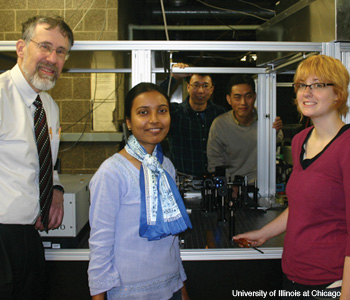Scatterings
Plasma Polarization Puzzler
University of Illinois at Chicago researchers produced pairs of 80-fs, 800-nm pulses using a Ti:sapphire laser and a Michelson interferometer.
 Front row: Robert J. Gordon (left), Sima Singha and Tana Witt. Back row: Youbo Zhao (left) and Yaoming Liu.
Front row: Robert J. Gordon (left), Sima Singha and Tana Witt. Back row: Youbo Zhao (left) and Yaoming Liu.
Polarization can be a funny thing. Intuitively, one might expect light from a plasma to have random polarization. But sometimes plasmas are created in part by non-random processes that lead to some degree of polarization. For example, gamma ray bursts from a collapsing star are somewhat polarized, as is the output of a mercury lamp. Polarization can be a clue towards the processes that create the plasma.
…Log in or become a member to view the full text of this article.
This article may be available for purchase via the search at Optica Publishing Group.
Optica Members get the full text of Optics & Photonics News, plus a variety of other member benefits.
